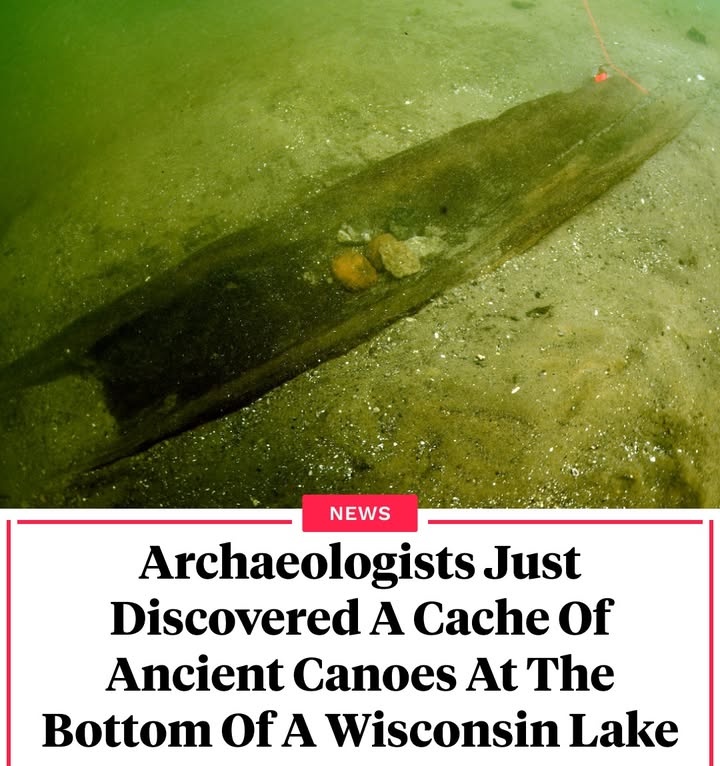Since 2021, researchers from the Wisconsin Historical Society have been uncovering a remarkable collection of ancient canoes submerged in Lake Mendota, shedding new light on centuries of Native American history in the region. Located in Madison, Wisconsin, Lake Mendota is the city’s largest lake, and beneath its surface lies a fascinating glimpse into the lives of early Indigenous peoples. To date, archaeologists have found up to 11 canoes, with the oldest dating back an astonishing 4,500 years, making it the oldest dugout canoe ever discovered in the Great Lakes area. This discovery offers a rare and invaluable window into the past, revealing the sophisticated ways in which ancient peoples traveled and lived.

The initial discovery began in 2021 when maritime archaeologists from the Wisconsin Historical Society retrieved a dugout canoe believed to be about 1,200 years old. The following year, further dives revealed another canoe, estimated to be roughly 3,000 years old, which at that time was the oldest canoe known in the region. Motivated by these findings, the team teamed up with Native Nations in Wisconsin to expand their explorations. Their ongoing efforts led to the identification of fragments from as many as nine more canoes, with materials ranging from elm to red oak. These fragments span thousands of years, from around 2500 B.C.E. to nearly 800 years ago, showing a continuous tradition of canoe use by Indigenous peoples throughout different historical periods.
The oldest canoe, carved from elm wood, is particularly significant because it dates back to the Late Archaic period—around 4,500 years ago, which is 2,000 years before the advent of farming and long before the construction of the first burial mounds in the area. This fact emphasizes the ancient roots of Indigenous communities and their ways of life, long before agriculture and permanent settlements became common. Researchers believe that these canoes were purposely sunk in shallow waters during the autumn to preserve them through the winter months, only to be retrieved and used again in the spring. Over time, changing shorelines caused by natural events such as droughts and floods buried these canoes beneath layers of sediment.
The discovery raises many intriguing questions. Amy Rosebrough, a state archaeologist involved in the project, wonders if these canoes represent just a small portion of what lies beneath Lake Mendota, asking whether there might be a “bathtub ring” of canoes around the entire lake, and speculating that other lakes in the region might hold similar treasures. These findings not only deepen our understanding of the area’s ancient inhabitants but also confirm long-held assumptions that Native peoples used dugout canoes extensively during the Late Archaic period for travel and transportation.
The canoes also offer insight into different historical periods in the region. Two of the discovered canoes date to the Middle Woodland period, a time when early farming, pottery-making, and burial mound construction were taking shape. By this period, some communities had become more sedentary, and established trade routes connected different groups. Several other canoes date from the Late Woodland period, when corn farming and effigy mounds were widespread. The most recent canoe, made from red oak, is from the Oneota period, marked by the development of permanent farming settlements.
These discoveries are taking place on ancestral land historically belonging to the Ho-Chunk Nation. Bill Quackenbush, historic preservation officer for the Ho-Chunk Nation, highlights the importance of these canoes as physical representations of long oral traditions passed down through generations by Native scholars. He expresses excitement about how modern technology, like ground-penetrating radar and sonar mapping, can help reveal even more about these ancient artifacts and the enduring legacy of Indigenous ingenuity.
While the two oldest canoes have been recovered and sent to Texas A&M University for freeze-drying and eventual display at the Wisconsin History Center, slated to open in 2027, the more fragile fragments will remain underwater to preserve their delicate condition. Researchers plan to continue exploring the lake with sonar equipment to map out further discoveries.
For many, these canoes help make ancient history feel more real and relatable. As Amy Rosebrough explains, showing someone a 5,000-year-old spearpoint might not evoke much reaction, but pointing to a canoe—a recognizable object—helps people connect more deeply to the past. It allows them to envision the lives of the people who built and used these canoes, fostering a stronger connection to the region’s deep and rich Indigenous history.
This extraordinary find not only enriches our understanding of the past but also invites us to appreciate the lasting presence and culture of Native peoples who have lived here for thousands of years.





